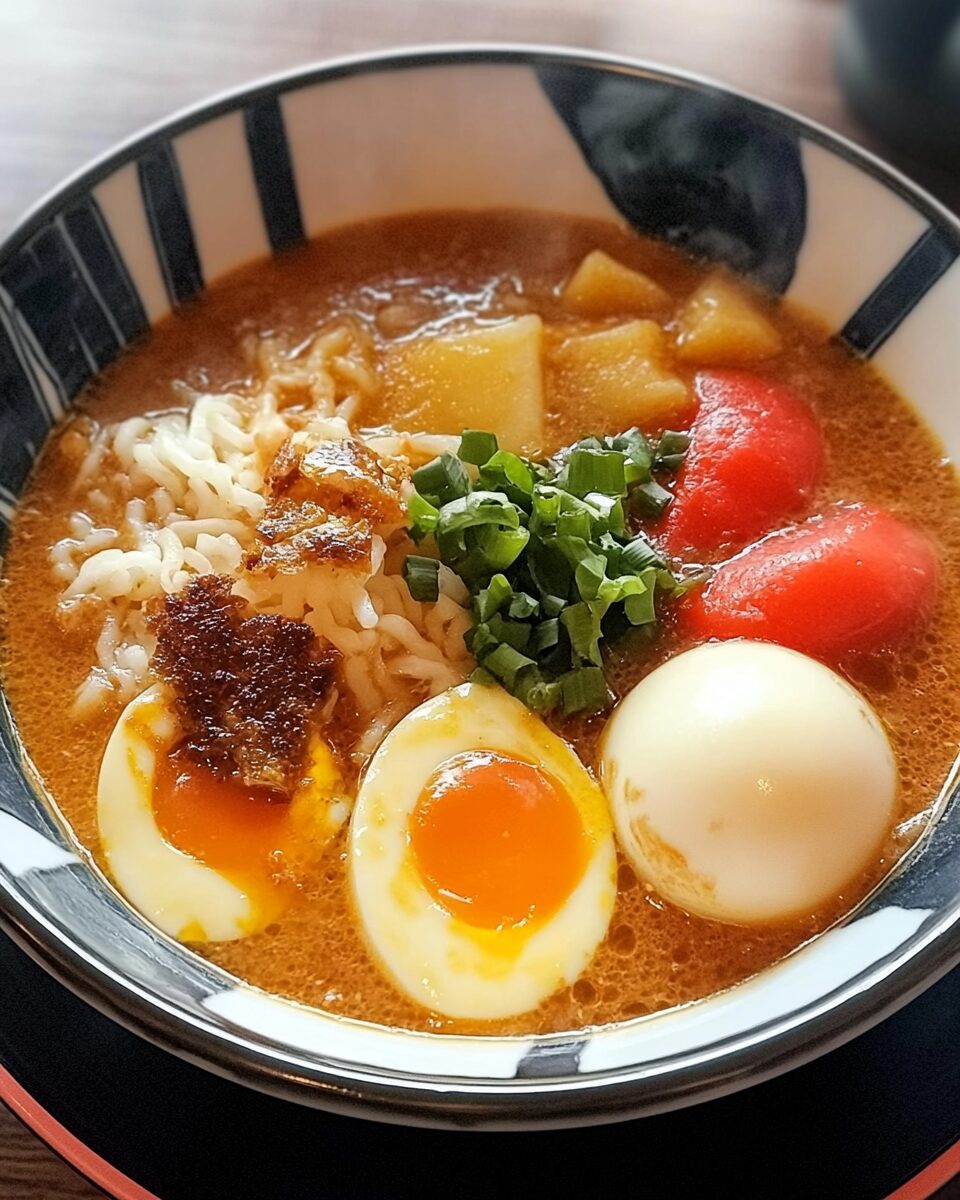Japanese curry, known as “kare” in Japan, is a beloved dish characterized by its rich, mildly spiced, and slightly sweet flavor. Unlike its Indian counterpart, Japanese curry has a thicker consistency and a more subdued heat, making it accessible to a wide range of palates. Typically served over steamed rice or with udon noodles, it’s a staple comfort food in Japanese households and has become popular worldwide.
Full Recipe:
Ingredients
- 2 tablespoons vegetable oil
- 1 pound beef stew meat, cut into bite-sized pieces
- 1 large onion, diced
- 2 cloves garlic, minced
- 2 medium carrots, peeled and chopped
- 2 medium potatoes, peeled and cubed
- 3 cups water
- 4 ounces Japanese curry roux (store-bought or homemade)
- Salt and pepper to taste
- Cooked Japanese short-grain rice, for serving
Directions
-
Sauté the Ingredients:
- Heat vegetable oil in a large pot over medium heat.
- Add beef stew meat and cook until browned on all sides.
- Stir in diced onion and minced garlic; cook until the onion becomes translucent.
-
Add Vegetables and Simmer:
- Add chopped carrots and cubed potatoes to the pot.
- Pour in water, ensuring all ingredients are submerged.
- Bring to a boil, then reduce heat to low and let simmer for about 20 minutes, or until vegetables are tender.
-
Incorporate the Curry Roux:
- Break the Japanese curry roux into pieces and add to the pot, stirring until completely dissolved.
- Continue to simmer for an additional 10 minutes, allowing the sauce to thicken.
-
Season and Serve:
- Season with salt and pepper to taste.
- Serve the curry over cooked Japanese short-grain rice.
Nutritional Facts (per serving)
- Calories: 350
- Total Fat: 15g
- Saturated Fat: 5g
- Cholesterol: 70mg
- Sodium: 600mg
- Total Carbohydrates: 35g
- Dietary Fiber: 5g
- Sugars: 5g
- Protein: 20g
The History of Japanese Curry
Japanese curry has an interesting history that traces back to the late 19th century. It was introduced to Japan by the British during the Meiji era (1868–1912) when Japan opened up to Western influences. At the time, British sailors and traders had already adopted Indian curry into their cuisine, modifying it to be thicker and milder to suit their tastes. This version of curry was brought to Japan and quickly gained popularity among the Japanese navy and military as a nutritious and filling meal.
By the early 20th century, Japanese curry became widely available in restaurants and households. In the 1950s, instant curry roux was introduced, making it even more accessible and easy to prepare at home. Today, Japanese curry is deeply embedded in Japanese cuisine and is enjoyed in many forms, from traditional curry rice to curry-filled pastries and curry-flavored ramen.
Why Japanese Curry is So Popular
- Mild and Family-Friendly – Unlike spicier curries from India or Thailand, Japanese curry has a mellow heat that appeals to both children and adults.
- Easy to Make – Thanks to store-bought curry roux, making Japanese curry at home is simple and requires minimal effort.
- Versatile and Customizable – It can be made with various proteins like beef, chicken, or seafood, and vegetables like carrots, potatoes, and onions.
- Comforting and Filling – With its thick consistency and deep flavor, Japanese curry is a satisfying meal, perfect for cold days or when craving a hearty dish.
- Widely Available – Whether in convenience stores, specialty curry restaurants, or homemade meals, Japanese curry is a staple that can be found everywhere in Japan.
Different Variations of Japanese Curry
Japanese curry is incredibly versatile, and over the years, many variations have developed based on regional preferences and adaptations.
- Katsu Curry – One of the most famous variations, katsu curry consists of a crispy breaded and fried pork or chicken cutlet served on top of a plate of curry rice. The crunchy texture of the cutlet contrasts beautifully with the thick, smooth curry sauce.
- Seafood Curry – This version uses shrimp, scallops, or squid instead of beef or chicken, adding a slightly briny flavor that pairs well with the rich curry sauce.
- Vegetable Curry – A great vegetarian option that focuses on hearty vegetables like sweet potatoes, bell peppers, eggplant, and mushrooms.
- Beef Stew Curry – Uses slow-cooked beef chunks, making the dish richer and more deeply flavored. Some recipes even include red wine for added depth.
- Curry Udon – Instead of rice, this variation uses thick udon noodles, allowing the curry sauce to coat the chewy noodles for a comforting bowl of goodness.
- Curry Bread (Kare Pan) – A popular snack in Japan, curry bread consists of a deep-fried or baked bread roll stuffed with Japanese curry filling.
How Japanese Curry Differs from Other Curries
Japanese curry stands out from other curry dishes around the world due to its unique preparation and flavor profile.
- Thicker and Heartier – Unlike Indian or Thai curries, which tend to be thinner, Japanese curry has a thick, almost stew-like consistency. This is achieved by using curry roux, which contains flour as a thickening agent.
- Sweeter and Milder – Japanese curry has a mild spice level and is often slightly sweet due to the addition of ingredients like honey, apples, or grated carrots.
- More Umami-Rich – The use of soy sauce, Worcestershire sauce, and dashi in some recipes gives Japanese curry a deep umami flavor not commonly found in other curries.
- Easy to Prepare – The use of pre-made curry roux simplifies the cooking process, making it an easy meal for home cooks of all skill levels.
Serving and Pairing Japanese Curry
Japanese curry is traditionally served with steamed rice, but there are many ways to enjoy it.
- Classic Curry Rice – The most common way to eat Japanese curry is by ladling it over a bed of steamed Japanese short-grain rice. It is often garnished with pickled vegetables like fukujinzuke or rakkyo.
- With Fried Foods – Pairing curry with fried items like tonkatsu (pork cutlet), ebi fry (fried shrimp), or croquettes adds a delicious crunch to the dish.
- With an Egg – A soft-boiled or raw egg yolk on top of the curry adds extra creaminess.
- With Bread or Roti – Japanese curry can also be enjoyed with toasted bread or naan, similar to how Indian curries are eaten.
Health Benefits of Japanese Curry
Despite being a hearty and comforting dish, Japanese curry offers several health benefits:
- Rich in Protein – When made with beef, chicken, or seafood, Japanese curry provides a good source of protein necessary for muscle growth and repair.
- Packed with Vegetables – Carrots, potatoes, and onions supply fiber, vitamins, and antioxidants.
- Contains Anti-Inflammatory Spices – The curry roux typically includes turmeric, which has anti-inflammatory and immune-boosting properties.
- Balanced Meal – When served with rice and protein, Japanese curry provides a well-rounded meal with carbohydrates, protein, and fats.
Common Mistakes to Avoid When Making Japanese Curry
- Not Cooking the Vegetables Properly – To achieve the best texture, carrots and potatoes should be tender but not mushy.
- Adding the Curry Roux Too Early – The roux should be added at the end of cooking to prevent burning and to maintain the smooth consistency of the sauce.
- Skipping the Simmering Process – Allowing the curry to simmer helps develop its flavors and enhances the overall taste.
- Not Stirring Enough – Stirring occasionally prevents the curry from sticking to the pot and burning.
Conclusion
Japanese curry is a dish that embodies comfort, tradition, and rich flavors. It has evolved from a British-inspired meal to a uniquely Japanese creation that is loved by people of all ages. Whether served with rice, noodles, or breaded meats, it remains a versatile dish that can be adapted to various tastes and preferences.
The beauty of Japanese curry lies in its simplicity and the ability to customize it to suit different flavors and ingredients. With its mild spice, rich umami, and satisfying texture, it’s easy to see why it has become a staple in Japanese households and around the world.

